©
These are albums of live music, some I recorded separately from the PA, others were made from my "sonic journal" tapes of PA mixes.
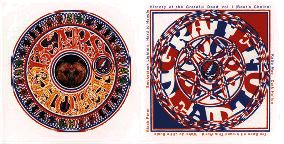
Bear's Choice, (Warner Bros. 1973.)
The first album made from what I now call my "sonic journals".
This album was excerpted from two of the shows at the Fillmore
East in Feb 1970, a show which was extra nice, as the mixing board
and the hall were sweet-sounding. The Allman Brothers were the
opener for the shows, and the next album is from their sets. The second act was Arthur Lee's band Love. Please read the note on DP4 below about this series of shows.
.
Here is an explanation of the marching bears found on the reverse cover: Bear Story
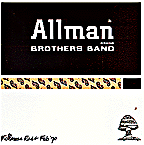
Allman Brothers Band
Live at the Fillmore East, Feb. 1970, Grateful
Dead Records (GDM)1997.
This album was compiled from the tapes of the three shows at the
Fillmore East on 11, 13, and 14 Feb 1970. The Brothers were a
fairly young band at the time and I think you will be pleased
by the high level of performance at these shows. The best performance
of each song was chosen for the CD. John Cutler and Jeffrey Norman
did an excellent job cleaning up the sound on these old tapes.
To the best of my knowledge there are very few good live recordings
of them around from this period. The Allmans's have their own
website called "Hitting the Web".
[liner notes]
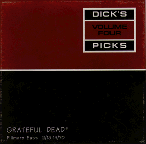
Dick's Picks v.4, Grateful
Dead Records (GDM)1996.
Here are more songs from the shows I derived Bear's Choice from... lacking
those parts previously released in Bear's Choice. It is a kind of musical "puree" made by mix-and-match. I had little say on the format here. In fact, I was criticised for suggesting that each night be released as a whole show (with the Bear's Choice parts included) on separate albums,in a set. But then, what do I know about such things? Perhaps if there is enough interest they may eventually do it. Each show was many hours long- way to long for more than a single show per night. I don't know about Love's usual gigging habits,but the other two bands liked to play long sets. Two set changes took time- the Allmans played a relatively long set, each night filled two 45 min reels- and there were jams. Love's set was pretty short, about 45 minutes. Sat night's set went on until well after midnight, Note on the box says "ends 5:38 AM. The Dead always played long shows in those days, during which they took a break, dividing their set into two parts as was the practice for almost their whole career. There are some missing tapes from 11 Feb and of some of the jams, also for a couple of Love's sets, tape was short and Love did not impress me, and I had not real interest in keeping them in my diary- so with the vain hope each night that they would improve, I used the same reel of tape over- thus I only have the last show- all their sets were less than 45 min and thus fit on a single reel. I always recorded all the bands and all the sets I mixed on all my shows like some people keep a diary, at least so long as I had enough money to buy reels of blank tape- sometimes I didn't, but cassettes were also made of all shows. We are going to search the cassette boxes to further details on these shows.
Ok, everybody- time for a little more history. I want to correct of a bit of false information about this series of shows which originated with Dick Latvala. It was his idea there was an "early show" and a "late show" on each night, which was based on the fact that this was a usual practice at the Fillmore East at the time for other shows. He claimed I must not have recorded any of the bands first sets, or somehow (not explained), only those tapes from the series were lost. This was based on his interpretation of some remarks made by Zacherle as he introduced the the Dead's (only) show on Saturday, which began shortly after midnight on Sunday. He persisted with this nonsense in spite of my efforts to convince him otherwise- which I found odd- since I was there and did the setups and did the sound mix for all three bands, while he was not even in the hall. The truth is that the year before the Dead had told Bill Graham they would not again do two shows on a night at the Fillmore East after a double show booked in Feb '69 with Janis Joplin and her new band Cosmic Blues. The band normally played two sets (you could call it a "split set") with a short break- 30+ min average, and did not like having to play veryshort sets to two different audiences, with a break of considerable length between sets. Also we- the crew- had protested about all the extra work we had to do setting up and tearing down for two shows. At that time, NO other venue required this practice, only FE. I think this is why Bill scheduled three bands for this series of shows, perhaps as a kind of get-even for our refusal to go along with his routine.
Anyone who managed to pass 6th grade math can figure out there could not have been two shows with three bands in a night- but for those who are math-challenged I will spell it out for you: Show starts at 8PM ...actually it never in the real world started exactly at 8, The show was quite late starting on Sat, apparently due to some problems with the gear- I don't remember the details. Allmans then played over an hour, averaging approximately an hour and fifteen minutes to an houra nd a half (check out their album). They played the same set of songs in the same order each night, with some jamming on Saturday. Allmans have a large setup similar to the Dead, with two drummers. First set change takes 30 min, rushing, 45 min at normal pace. Second act Love plays a very short set, between 30 and 45 minutes. The second set change took 45 minutes due to the two large setups which had to be moved. The Dead played in a split set format as usual, with the second set starting off with acoustic, and then segueing into electric, total Dead with the inter-set break was about 2 and a half to three hours, rather a bit shorter than (the sometimes seen in those days) four full hours, except for the Sat night show- which ended at well past 5 AM- according to my note on the tape box, at 5:58 AM. Add this all up, and you get a total of an absolute minimum of 5 hours and fifteen minutes to a max of a bit over 8 hours (Saturday's show lasted ~9 hours including the extensive jams- none of which have been included on CD release- and something I am pushing for. There also were jams each night (can't find all the tapes of the jams). The second show start time at FE on nights the usual two show format was followed was 11:30, with a one hour audience clearance break, so the first show always ended at 10:30,and the FE staff were like a mob of Nazis on that timing. Even an F student in math can see that there is only two and a half hours total time for both music and set changes available between 8 and 10:30. Let me state here unequivocally, that there were NO "early or late shows" which no-one, for some unexplained reason bothered to record- (FE sound staff also made secret-from me- recordings in the basement fro a tap in the PA lines- and their tapes duplicate mine except the used larger reels and had some bits not on my tapes due to my changing reels in mid song. I say unexplained, because I even have tapes of the sound checks in my archives. Actually to be accurate there were no "late shows", since the shows all were ticket for and officially started at ~8PM during this run. Anyone who can come forward with a genuine ticket (verifiable by GDP and BGP as authentic) for any show in this run with a starting time other than 8PM will be given US $1000 cash by me personally. Hey-- why don't all those who so fervently believe (while none were there on the nights) that there was indeed two shows- why don't you all get together and start a fund by collecting $100 from each believer and put it in a trust. If I prevail on this, I get the whole kitty, and if I am proven wrong, each person gets his or her $100 back and the person who can prove it gets my $1000. Put your money where your foolish mouth is. I am tired of hearing this bloody nonsense.
As a further note, the band did not play any "other venues" in NYC during the period around the date (nor in fact, around any other date, anywhere while on tour). They were under contract to BG, and trust me, he would never allow any band he contracted to any of his venues to play anywhere else in the vicinity, especially near the date. This had been a critical factor in the demise of the Carousel Ballroom in San Francisco in 1968.
There are many tapes in circulation which claim to be of "rare" shows. The reason these shows are "rare" is usually because they never happened. In addition there are many tapes in circulation which are not as marked. The only way a person can be sure the tape in their hand is of the show written on the box is if they were at the show and recorded the tape themselves on their own machine. From the feedback I have had, and the tapes I have listened to, I estimate 30% or more of both audience and "board" tapes/CD's are either mislabeled or faked.
[liner notes]
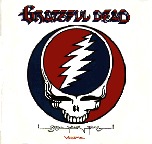 Steal Your Face, (Arista)/Grateful
Dead Records (GDM) 1976.
Steal Your Face, (Arista)/Grateful
Dead Records (GDM) 1976.
This is one that I would just as soon forget. The master tapes
were a disaster of epic proportions, requiring a complete over
dubbing of all the vocals and many of the instrumental tracks.
I had absolutely nothing to do with the recording of the master
tapes, and was called in to try to "fix" it. Phil Lesh
and I were given only 18 days to rebuild this "titanic".
Fact is, of course, no-one could make a silk purse out of this
pig's ear.
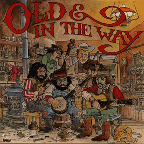 Old And In The Way,
(Round Records/Sugar HIll/RykoDisc/GDM) Grateful
Dead Records (GDM) 1975.
Old And In The Way,
(Round Records/Sugar HIll/RykoDisc/GDM) Grateful
Dead Records (GDM) 1975.
With the formation of the group, Old and in the Way, I had a wonderful
opportunity to try the various ideas I had about the production
of a realistic stereo sound from multiple microphones. Binaural
recordings are traditionally done with a simple stereo pair. I
experimented with the placement of the mics, and to a certain
extent with kinds of mics. I was limited in the choices available
and I vastly preferred omnidirectional types. Incidentally, none
of the microphones that were used in the recording were also fed
to the PA. The mics were clipped onto the PA stands. I was able
to capture a stereo "space", which while different from
the actual on stage sound, gives the listener the impression of
being in amongst the performers, and isn't dependent on the listener
being in any particular position with regards to the placement
of the speakers. Something like a hologram, is the way I like
to think of it. In contrast with my sonic journal tapes, this
was a purpose recording not related to the PA mix at all.
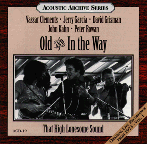 That High Lonesome Sound,Acoustic
Disc 1996.
That High Lonesome Sound,Acoustic
Disc 1996.
This is the second album from the 1973 performances of Old and
in the Way. David Grisman has said that he is hoping to release
more of the tapes from this now classic band in the future, but
I think that the sound may not be as good as these last few shows
were. It was a learning experience for me, coupled with the usual
sound-in-the-hall difficulties facing a band playing small venues.
It is too bad that the band didn't continue for a while longer.
[liner notes]
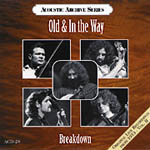 Breakdown,
Acoustic
Disc 1998.
Breakdown,
Acoustic
Disc 1998.
And here (to my amazement) is the third album derived from the two final concerts I recorded of Old and In the Way at the Boarding House. I didn't think that there were that many songs but here it is... So much for my memory of events over 25 years ago... No, I am NOT going to blame it on "the drugs" (I seem to remember we did do some from time to time in those days).
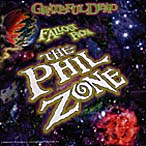 Fallout from the
Phil Zone, Grateful
Dead Records (GDM) 1995.
Fallout from the
Phil Zone, Grateful
Dead Records (GDM) 1995.
In this new release, Phil has chosen about 63% of the songs from
my sonic journal recordings, including the New Speedway Boogie
song which turns out to be one of my rehearsal tapes, found in
a box marked "unknown". This was probably due to the
tape becoming separated from its original, marked box. In the
period of mid '69 to mid '70, we did frequent rehearsals, as well
as sound checks at all the shows. I have always thought that this
was why the records of the period, Workingman's Dead and American
Beauty, are among the best of their studio efforts. Later they
became lazier about both things. Phil has chosen many of the same
songs which I for years tried to get put on a record. Especially
a hot live version of Viola Lee Blues and The Mason's Children.
The Mason's Children was never "good enough", (don't
ask ME why either). I am really glad that I was at the Rio Nido
gig (Pig's Midnight Hour), which occurred during the period when
I was not on the Dead's crew, but I just came out to the show
and taped it. The tape was also recorded in the separate channel,
one for vocals and the other for instruments setup, which I used
for all my recording of live gigs until late 1968. This was similar
to the Beatles early stereo recordings. This technique gave a
powerful "space" effect, but is hard for the modern
listener to accept. The reason for this illusion of space is that
the mikes on the front of the stage are all in one side, and the
mikes on the back of the stage in the other, so the two signals
have a natural time difference. The ear interprets this as space.
Phil resolved this difficulty by mixing to mono. I probably would
have tried a digital technique in an attempt to preserve the spatiality,
but unfortunately I was not consulted during the album's preparation.
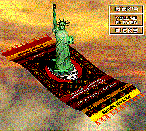
Dick's Picks v.11, Grateful
Dead Records (GDM) 1998
This was made from one of my sonic journal tapes, pretty much the standard for that period.

So Many Roads, Grateful
Dead Records (GDM) 1999
This compilation contains many of my sonic journal tapes: All of disk one, and one cut on disk two. Surprise! I received my very first gold record for my part in it.
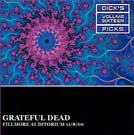 Dick's Picks v.16,
Grateful
Dead Records (GDM) 1999
Dick's Picks v.16,
Grateful
Dead Records (GDM) 1999
Another from my sonic journals. Oddly, the venue was a revived Old Fillmore. I don't recall much about this show, but I do remember we all went to the Stones show the following night in Oakland. They blew up all their Ampeg amps during their first set. The Dead offered to help them in their need, and RamRod, Jackson and Sonny Herd drove into the city and brought the band's souped-up Fender amps back over to the coliseum, arriving just in the nick of time for the Stones to go on after Ike and Tina's opener. Personally, I thought they sounded much better on the Fenders than on their somewhat wimpy Ampegs. (What ever happened to Ampeg?) Later, in December, I did the sound for the free Stones show out at Altamont. The Airplane and the Dead were both supposed to play at that show, but...that's another story... and yes, I do have a journal of that gig too.
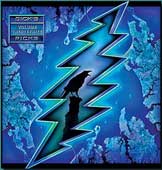 Dick's Picks v.23, Grateful
Dead Records (GDM) 2001
Dick's Picks v.23, Grateful
Dead Records (GDM) 2001
Made from one of my sonic journal tapes, this concert was not chosen my me, in fact I was not told it was in preparation until after it was finished. I had no input and I don't have any liner notes on it. It is certainly typical of this period, but I don't remember this show as anything special, and I might have chosen another show from that tour.
Due to a lack of space on the last disk, the encore "One More Saturday Night" was left off. I would not have done this, even if it meant putting it on a different disk with a notice as to where in the concert it belonged. I have been told that whenever one of my tapes is to be made into an album in the future, it will be with my full participation, so this sort of thing should end here.
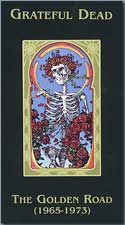 Golden Road, Grateful
Dead Records (GDM) 2001
Golden Road, Grateful
Dead Records (GDM) 2001
In this boxed set you are going to be treated to a lot of my early recordings as well as getting all the Warner's albums re-mastered with HDCD encoding, a bit pricey, but a VERY worthy set. About 40% of the bonus tracks are taken from my sonic journals. I have been awarded my second gold record for participating in this compilation.
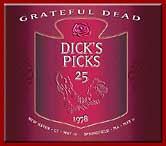 Dick's Picks v.25, Grateful
Dead Records (GDM) 2001
Dick's Picks v.25, Grateful
Dead Records (GDM) 2001
One half of this double-show set is produced from one of my more unusual tapes. It is not a journal tape, but is a one I made at a GD show I attended while on the road with Bob Hunter and Comfort, whom I was helping with the PA sound and making (journal) recordings.
The Dead were playing on one of our days off, and we were in town. I arrived at the New Haven show with my Nagra and a couple of precious reels of blank tape. I was able to convince Betty Cantor, who was at that time the Dead's recordist, to allow me the use of a pair of unused busses on her recording board.
The board was fed by a split of the stage mics. I was able to choose just a select few of the massive array of mics setup by Healy for the PA. I think he had at least 40 or perhaps more on stage. I may have used 16-18 or so of them- I don't really remember- it could have been fewer. I do not use many mics to get a good mix. In fact, using more mics than the absolute minimum are in my opinion the major reason most mixes of many bands' live shows are smeary have poor stereo separation and lack detail (space). In this package you will have the unique opportunity to directly compare my technique with that of Betty on consecutive shows, using identical resources to mix from. It is a perfect representation of our distinctly different mixing philosophies.
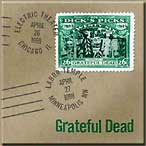 Dick's Picks v.26, Grateful
Dead Records (GDM) 2001
Dick's Picks v.26, Grateful
Dead Records (GDM) 2001
One more--- I guess 'someone in charge' thinks my tapes are "the kind". I agree for the most part, at least to the extent that I have always thought I was very lucky to have been the soundman during a period I have come to think of as the bands' golden Age. We had so much fun in those days we were always afraid it (fun) was going to be made illegal. It wasn't, but I think it finally became a victim of what the Merry Pranksters used to say: "Nothing Lasts". In the end it did indeed last a lot longer than anyone expected. The Grateful Dead story book may not yet be closed... I would not be surprised to see the name "Grateful Dead" on a show ticket in the near future.
That said, I was once more asked to provide some liner notes for this CD: [liner notes]
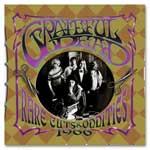 Grateful Dead Rare Cuts and Oddities 1966, Grateful
Dead Records (GDM) 2005
Grateful Dead Rare Cuts and Oddities 1966, Grateful
Dead Records (GDM) 2005
Old, but surprisingly good, considering my inexperience in those days. These cuts are all in my early journal standard, left channel with the PA feed and right with the rest of the instruments. My Sonic Journals were not made with a mind for release, only as a personal diary of my mixes, so I followed the easy path. Later, after rejoining the band in late '68 I moved the vocals, and changed the set-up, regretfully losing some of the special stereo space the early mixes provided.
Liner Notes:[liner notes]
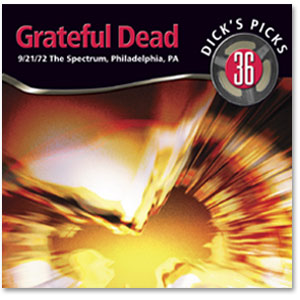 Dick's Picks v.36, Grateful
Dead Records (GDM) 2005
Dick's Picks v.36, Grateful
Dead Records (GDM) 2005
1972 saw my return to the band after an absence of 2 years. The year was exciting for me although I was having some problems with the crew, many of whom had come to work after I had gone, and resented my drive to improve things onstage and with the equipment, which I decided was obsolete for the most part. They preferred to let things stay the same- an attitude I thought was due to simple laziness. The various problems, particularly the one of getting those who did my job while I was away to back off and allow me to return to my work, eventually inspired me to design the Wall of Sound, a staging system which eliminated the mixing desk (my main job), and allowed the musicians themselves to adjust all the sound to their liking- but that is another story... The hassles however, did not interfere with my ability to mix, and the band played many fine shows during this period- this one is a good example.
Liner Notes:[liner notes]
Janis Joplin in Concert, CBS 1971.
Now this is a complete shambles made of my tapes of a very good
performance. Three of the songs on this album: Roadblock, Flower
in the Sun and Summertime, were taken from my tapes which were
stored at the Alembic studios in SF during the time I was in jail.
Dan Healy took my tapes of the Big Brother and the Holding Company
show at the Carousel Ballroom in June of 1968 to Elliot Maser,
claiming that they were "his" (Actually, he wasn't even
present at the show, but he had heard them, and knew how extraordinary
they were). Maser decided to use three of the songs, but re mixed
them to "make them match" the poor quality of the other
recordings he was using in the album. When Healy learned that
they were going ahead with them, he belatedly told them that "Bear
was involved" in the recording (they were ENTIRELY my work).
He signed the contract (!), but when I learned what Maser had
done to the stereo space (I used the Beatles', vocals in one channel
and instruments in the other, technique, same as at Rio Nido,
mentioned above), I refused to sign, and told them that they must
not release the album mixed the way it was. They went ahead, (believing
they had acquired the rights from Healy) and I was unable to stop
them. I never signed a release for the rights to the tapes, but
did agree to drop my suit against them for that one release (they
then paid me a small royalty). The songs used were Summertime,
Roadblock, and Flower in the Sun.
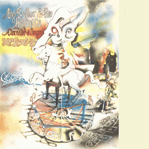
Big Brother Live In Concert at the Carousel Ballroom, 23
June 1968. (SONY/Legacy).
NOTE: (As of Sept 2000). I have word that Sony Music is at last ready to offer a contract agreeable to (most of) my terms, which means the album may actually get into production sometime soon.
I believe this album will be hailed as the definite Big Brother live album of all time. Perhaps on some other night they gave a better and more energetic performance, I don't know-- I wasn't lucky enough to be present at it. I was at this one, and I thought at the time it was exceptional. The important thing is, these tapes survived. This is Janis at her absolute peak, and the band was rarely so "on" as they were at these shows. They were kicking ass and having a hell of a good time. Listeners should realise that in those days we didn't yet have onstage monitors for the singers and they depended on the sound coming back from the hall and the sound of their instruments to find the pitch, so the singing sometimes is a bit off. That is how it was then and most multi-tracks of live concerts of the era were overdubbed later to "fix" this problem. Is that a "live album? (...Sort of.) This album is a real concert, warts and all. Working with Paul Stubblebine, the tapes of the weekend's concerts were transferred to digital using the HDCD encoding process. If played on a player with the Pacific Microsonics decoder chips, this will give essentially a 20-bit signal. Not all the tapes managed to make it through to the present, and I didn't have enough blank tape at the time to record all the shows. However, Sunday was far and away the hot night and we have all of that show. The
sound is much better than I thought it would be, no tape hiss, and no
noticeable distortion or evidence of deterioration of the recording media.
This is surprising considering these tapes are 31 years old
and have not always been stored under ideal conditions. In fact,
I think the sound is a "monster". A unique character of the technique
I used in my "diary" or sonic journals of that era was to
put the PA signal in the left channel and all instruments
not sent to the PA (most of them, usually) were placed in the right. The PA systems of the day were barely able to manage the vocals and drums. This odd sounding (to modern ears) technique produces a nice fat, three dimensional sound when it is played back. The sound is so hot and LIVE that I think few listeners will complain about the vocals and drums coming from one side. Turn it up good and loud! You could even try moving the speakers around, or use three channels, with the right side duped into a second outside channel, with the left channel as center! There are 13 songs from Sunday and one bonus track from Saturday on the album, which is 71 minutes long. The second version of Call on Me shows how different the band's interpretation of a song could be from one performance to the next. The album cover will be an adaptation by the artist, Crazy Arab, of the poster he did for an earlier show in May (BB cancelled that weekend). The set list will be along the right hand edge in the finished cover art.
Set
List
I have a lot of tapes stored in the Dead's tape vault. Virtually
every band that played on the same bill with the Grateful Dead during my years as soundman, and who did not bring their own soundman,
was recorded. I would be very interested
in working with any of the bands concerned to see if the tapes
represent anything worth releasing. I will post the list once it is OCR'ed (a big job!).
Bearhome Enameling
Enamels Castings
Carvings Graphics
Logo Music
Essays



 Steal Your Face, (Arista)/Grateful
Dead Records (GDM) 1976.
Steal Your Face, (Arista)/Grateful
Dead Records (GDM) 1976.  Old And In The Way,
(Round Records/Sugar HIll/RykoDisc/GDM) Grateful
Dead Records (GDM) 1975.
Old And In The Way,
(Round Records/Sugar HIll/RykoDisc/GDM) Grateful
Dead Records (GDM) 1975.  That High Lonesome Sound,Acoustic
Disc 1996.
That High Lonesome Sound,Acoustic
Disc 1996.  Breakdown,
Acoustic
Disc 1998.
Breakdown,
Acoustic
Disc 1998.  Fallout from the
Phil Zone, Grateful
Dead Records (GDM) 1995.
Fallout from the
Phil Zone, Grateful
Dead Records (GDM) 1995. 

 Dick's Picks v.16,
Grateful
Dead Records (GDM) 1999
Dick's Picks v.16,
Grateful
Dead Records (GDM) 1999  Dick's Picks v.23, Grateful
Dead Records (GDM) 2001
Dick's Picks v.23, Grateful
Dead Records (GDM) 2001  Golden Road, Grateful
Dead Records (GDM) 2001
Golden Road, Grateful
Dead Records (GDM) 2001  Dick's Picks v.25, Grateful
Dead Records (GDM) 2001
Dick's Picks v.25, Grateful
Dead Records (GDM) 2001  Dick's Picks v.26, Grateful
Dead Records (GDM) 2001
Dick's Picks v.26, Grateful
Dead Records (GDM) 2001  Grateful Dead Rare Cuts and Oddities 1966, Grateful
Dead Records (GDM) 2005
Grateful Dead Rare Cuts and Oddities 1966, Grateful
Dead Records (GDM) 2005  Dick's Picks v.36, Grateful
Dead Records (GDM) 2005
Dick's Picks v.36, Grateful
Dead Records (GDM) 2005 
![]()